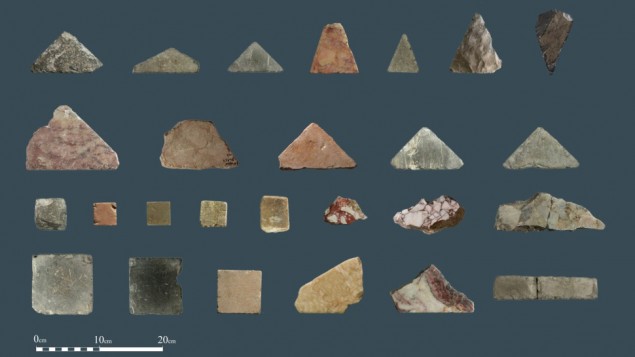

Hundreds of lavish stone floor tiles believed to have decorated the Second Temple in Jerusalem have been identified in rubble removed from the Temple Mount, archaeologists announced Tuesday.
The bits and pieces of 2,000-year-old marble flooring were found in fill removed from the contested holy site in the late 1990s when the Jerusalem Islamic Waqf, the institution overseeing the al-Aqsa Mosque compound on the Mount, carried out excavations as part of the construction of a subterranean mosque in an area known as Solomon's Stables.
Since operations began in 2004 to recover artifacts from the tens of thousands of tons of dirt dumped outside the Old City, the Temple Mount Sifting Project has found some 600 colored stone floor tile fragments that the organization's director contends came from the temple built by King Herod.
"This represents the first time that archaeologists have been able to successfully restore an element from the Herodian Second Temple complex," Zachi Dvira, co-founder and director of the Temple Mount Sifting Project, said.
Herod, a Roman client king who ruled Judea in the first century BCE, carried out extensive renovations of the Jewish holy site, grandly expanding the Temple Mount to its current dimensions.
Of the 600 floor tile fragments, "more than 100... definitively dated to the Herodian Second Temple period" because of their style, the organization said in a statement.
If their provenance is confirmed, the floor tiles would be among a small handful of artifacts definitively from the Second Temple, including the Temple Warning Stone and the trumpeting place inscription, both at the Israel Museum.
"This type of flooring, called 'opus sectile,' Latin for 'cut work,' is very expensive and was considered to be far more prestigious than mosaic tiled floors," said Frankie Snyder, an expert on ancient Herodian-style flooring who works with the Temple Mount Sifting Project. She noted that opus sectile floors only appeared in Israel during Herod’s reign.
She recreated an approximation of the temple courtyard flooring "using geometric principles, and through similarities found in tile design used by Herod at other sites."
Gabriel Barkay, co-founder and director, said the find "enables us to get an idea of the Temple's incredible splendor."
A reproduction of the tiles will be presented to the public later this week at the City of David Archaeological Conference in Jerusalem. The Temple Mount Sifting Project is supported by the City of David Foundation and is under the auspices of the Nature and Parks Authority